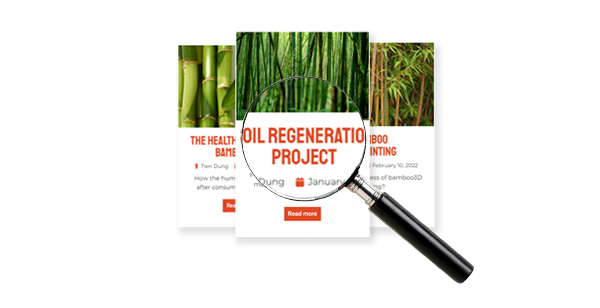Solving the high costs of shipping and production of bamboo goods
The three big problems that bamboo businesses face are:

- Bamboo does not have the ideal whole body for manufacturing – a producer must divide the circular body into many bamboo slats, flatten the slats, and then join them together as a solid panel before it can be used to manufacture solid commodities like its wood counterparts.
- Bamboo is not wood but instead lives in the family of grass. Therefore, it contains more water than wood. Before gluing bamboo slats together, forming the bamboo panels, a manufacturer must dry bamboo to a moisture content level of less than 7% in a dry room or tanks in order for the glue to function as needed.


- Bamboo has a density of around 40 pounds per cubic foot (outlink), which is comparable to oak. Because the bamboo panels are made entirely of bamboo, they will be slightly heavier than a similar-thickness oak plywood panel; even though most oak plywood contains a lower density species for the interior plies.

Currently, we squander at least 40% of the bamboo biomass in order to produce any goods. Because of the different size and emptiness of a bamboo body, the needed transit area from plantation to factory is not efficient. The manufacturing process is very labor intensive and hazardous to one’s health due to fine dusts that production creates.
With bamboo 3D printing, we wouldn’t waste any biomass, transportation expenses and emissions are reduced by at least 50%, and manufacturing time is reduced by up to 80%.
The possibilities of available bamboo products would be limitless.
As a result, bamboo products require not only more production processes than wood, but also higher shipping expenses due to their density. BambooVision saw only one possible answer to solve these problems: BAMBOO 3D PRINTING

For a bamboo 3D printer, the aim was to employ as much biomaterial as possible. Shredded bamboo powder, water, and various glues served as the basis for the printer. The bamboo 3D printer could produce products of varying consistencies, utilizing several kinds of glue to bind them.

Because of the entire circular economy, which is built on bamboo as the most sustainable bio-filler for a 3D printer to employ, bamboo 3D printing is the solution mankind needs. The method would slash production and transportation expenses immensely.
Bamboo 3D printing would not only serve to solve the complex manufacturing processes, transportation logistics of bamboo culms, and warehousing issues, but would also provide an endless variety of possibilities to use bamboo as a raw material.
The quality of the bamboo could not be an important element in their process; if it is only use as a bio-filler. This basically means that we would only need to set up a small facility near a bamboo plantation or forest and would use every single piece of bamboo as raw material, including the leaves and roots. It would only require it in powder form, which simplifies transportation and reduces the required space and weight.

To begin, consider the linear economy, which is the polar opposite of a circular economy. This is the process through which a resource, such as a raw material, is extracted from its source and transformed into something useful. When it is no longer useful, required, or wanted, it is discarded. This take-make-waste cycle adds to garbage and pollution.
The circular economy, on the other hand, takes a more sustainable approach to the utilization of the planet’s resources. There are three key concepts that should guide the operation of a circular economy:
- Waste and pollution should be avoided.
- Maintain the usage of items and supplies.
- Restore natural systems.

Bamboo heal the earth
Within 8 years, bamboo may be utilized to repair dead or dry land. During its development, it absorbs all of the chemicals and acids from the ground. Infertile ground can be used for farming again as a result of this process.
Bamboo forest create fresh air
The conversion rate of CO2 of bamboo leaves is one of its finest characteristics; bamboo leaves convert up to more than three times that of conventional leaves of other plants. Within 6 weeks, 80 percent of the bamboo leaves will have grown. You may breathe pure air while walking through the bamboo forest.
Low transportation effort
The notion of placing a shredder facility right at the bamboo forest would save transportation of the culm to the factory, bamboo panels to item manufacturers, and, more importantly, reducing the needed space for the shipment of bamboo as raw material.
Nearly zero CO2 pollution in the production
Aside from transportation, there is no stage in the manufacturing process that emits CO2.
Low packagings use
The items of 3D printing are specifically requested; there is no requirement for a single
item to be prepackaged.
Huge varieties of daily use products
With bamboo 3D printing, the number of products designs that can be provided to end users at a reasonable price is infinite.
No wasted policy
Focusing on biodegradable, reusable products and raw materials is the ultimate goal. The Bamboo 3D printing products would be reusable and biodegradable within 15 years estimated.
Circular Economy of Bamboo Businesses
Bamboo might play an important role in the transition to a circular economy by offering a feasible, bio-based substitute for non-renewable, carbon-intensive ‘techno-cycle’ materials. This fast-growing grass plant may be utilized to make a wide range of durable and consumable items, which can often replace those produced of man-made materials.



